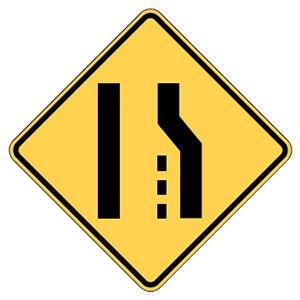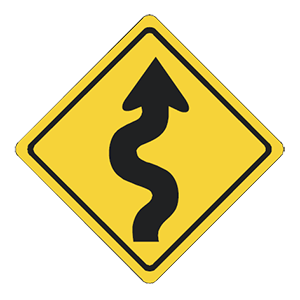2025 Illinois Permit Test 16
The following questions are from real DMV written tests. These are some of the actual permit questions you will face in Illinois. Each permit practice test question has three answer choices. Select one answer for each question and select "grade this section." You can find this button at the bottom of the drivers license quiz. For a complete list of questions and answers for Illinois please visit https://cheat-sheets.dmv-written-test.com/en/illinois/car.
Number of Tests
Number of Question
Passing Score
1. To turn left from a multilane one-way street onto a one-way street, you should start your turn from:
Explanation
When turning left from a one-way street onto another one-way street, you should begin the turn from the far left lane.
2. This road sign means:

Explanation
Warning signs provide notice to road users of a situation that might not be readily apparent and are usually yellow with black markings. This sign alerts drivers to the right lane ending and tells them to prepare for potential merging traffic.
3. When passing on the left of a vehicle, it is safe to move back into the right lane:
Explanation
When passing another vehicle on its left, you may move back into the right lane when the headlights of the passed vehicle can be seen in your rearview mirror. Always signal before changing lanes.
4. Your car must have a horn that can be heard from a distance of 200 feet.
Explanation
All vehicles must have a horn that can be heard from 200 feet away. Sirens, whistles, and bells are allowed only on authorized emergency vehicles.
5. If driving in fog, a driver should turn on the high beam headlights to increase their field of vision.
Explanation
While it is not advisable to drive in fog, if you must drive in foggy conditions, you should drive with the headlights set on dim or use fog lights.
6. Before a driver can regain driving privileges after losing them for failure to pay damages caused by a crash, the driver must file proof of financial responsibility with the Secretary of State’s office.
Explanation
Drivers without liability insurance who are at fault in a crash that results in injury, death, or property damage must provide a guarantee of payment to the Secretary of State's office. Failure to post this security may result in suspension of their license.
7. In urban areas, drivers moving out of an alley, building, private road, or driveway do not need to come to a complete stop before entering the roadway if the roadway is clear of traffic.
Explanation
When emerging from an alley, building, private road, or driveway, a driver must come to a complete stop and yield the right-of-way to other drivers and to pedestrians.
8. After a train clears a crossing that has flashing signals, drivers may proceed only after the lights have stopped flashing and no second train is coming on another track.
Explanation
At a railroad crossing, a driver may proceed only after the gate is all the way up, the lights are no longer flashing, or the flagger has signaled traffic to proceed. A driver should visually check all the tracks for any additional oncoming trains or railroad equipment before proceeding.
9. "No passing zone" signs tell drivers:
Explanation
If you come across a "No passing zone" sign, it is not legal to pass in the indicated area. You are likely driving in an area with restricted visibility where it would be unsafe to pass another vehicle.
10. While driving at night, a vehicle coming toward you has its high beams on, making it hard for you to see the road ahead. You should:
Explanation


